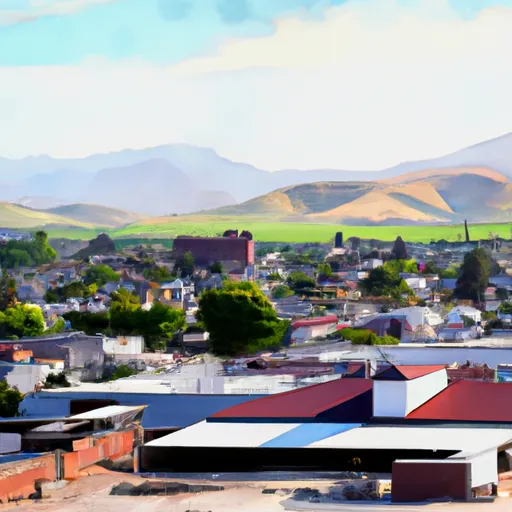-
 Snoflo Premium
Snoflo Premium
Get unlimited access to all our content
With no Ad interruptions! - Start Your Free Trial Login with existing account
Hollister
Eden Index
Climate
9.2
•
Recreation
3.5
•
Community
3.2
•
Safeguard
5.7/10

Hollister, California, located in San Benito County, offers a pleasant Mediterranean climate with warm, dry summers and mild winters. The region experiences an average annual temperature of around 70°F (21°C) and enjoys approximately 300 days of sunshine per year. However, it can get quite hot during the summer months, with temperatures often soaring above 90°F (32°C). The area receives minimal rainfall, averaging around 14 inches per year, and is known for its clear, blue skies.
Hydrologically, Hollister is not dominated by any major bodies of water. However, there are smaller creeks and streams that flow through the region, providing water sources for vegetation and wildlife.
Hollister's natural surroundings offer numerous outdoor recreation opportunities. The nearby Pinnacles National Park is a popular destination for hikers, climbers, and nature enthusiasts. Known for its unique rock formations and diverse flora and fauna, it offers several trails of varying difficulty levels. Additionally, the nearby Vernal Pool Trail provides a chance to explore the region's unique seasonal wetlands and witness the stunning wildflower displays during spring.
Overall, Hollister, California, provides a favorable climate for enjoying outdoor activities, and its proximity to natural attractions offers ample opportunities for exploration and recreation.
What is the Eden Index?
The Snoflo Eden Index serves as a comprehensive rating system for regions, evaluating their desirability through a holistic assessment of climate health, outdoor recreation opportunities, and natural disaster risk, acknowledging the profound impact of these factors on livability and well-being.
Climate Health Indicator (CHI): 9.2
Hollister receives approximately
377mm of rain per year,
with humidity levels near 62%
and air temperatures averaging around
15°C.
Hollister has a plant hardyness factor of
9, meaning
plants and agriculture in this region tend to thrive here all year round.
By considering the ideal temperature range, reliable water supplies, clean air, and stable seasonal rain or snowpacks, the Climate Health Indicator (CHI) underscores the significance of a healthy climate as the foundation for quality living.
A healthy climate is paramount for ensuring a high quality of life and livability in a region, fostering both physical well-being and environmental harmony. This can be characterized by ideal temperatures, reliable access to water supplies, clean air, and consistent seasonal rain or snowpacks.
Weather Forecast
Streamflow Conditions
Central California Coastal
Area Rivers
Central California Coastal
Snowpack Depths
Central California Coastal
Reservoir Storage Capacity
Central California Coastal
Groundwater Levels
Recreational Opportunity Index (ROI): 3.5
The Recreational Opportunity Index (ROI) recognizes the value of outdoor recreational options, such as parks, hiking trails, camping sites, and fishing spots, while acknowledging that climate plays a pivotal role in ensuring the comfort and consistency of these experiences.
Access to outdoor recreational opportunities, encompassing activities such as parks, hiking, camping, and fishing, is crucial for overall well-being, and the climate plays a pivotal role in enabling and enhancing these experiences, ensuring that individuals can engage in nature-based activities comfortably and consistently.
Camping Areas
| Campground | Campsites | Reservations | Toilets | Showers | Elevation |
|---|---|---|---|---|---|
| Coyote Lake County Park | 74 | 796 ft | |||
| Henry Coe State Park | 20 | 2,715 ft | |||
| Hollister Hills State Veh Rec Area | 125 | 742 ft | |||
| Fremont Peak State Park | 21 | 2,768 ft |
Nearby Fishing
Nearby Ski Areas
Catastrophe Safeguard Index (CSI):
The Catastrophe Safeguard Index (CSI) recognizes that natural disaster risk, encompassing floods, fires, hurricanes, and tornadoes, can drastically affect safety and the overall appeal of an area.
The level of natural disaster risk in a region significantly affects safety and the overall livability, with climate change amplifying these risks by potentially increasing the frequency and intensity of events like floods, fires, hurricanes, and tornadoes, thereby posing substantial challenges to community resilience and well-being.
Community Resilience Indicator (CRI): 3.2
The Community Resilience Indicator (CRI) recognizes that education, healthcare, and socioeconomics are crucial to the well-being of a region. The CRI acknowledges the profound impact of these elements on residents' overall quality of life. By evaluating educational resources, healthcare accessibility, and economic inclusivity, the index captures the essential aspects that contribute to a thriving community, fostering resident satisfaction, equity, and social cohesion.

